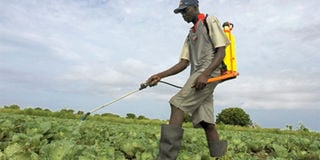How to safely use pesticides

A farmer sprays his crops to prevent the spread of pests on a farm. Experts recommend safe use of pesticides. pHOTO/panos
What you need to know:
Insecticides are toxic to both pests and humans. However, they need not be hazardous to humans and non-target species. Following good housekeeping practices is key to safety.
Farmers face a lot of challenges in growing maize which must be addressed. Weeds, insect pests and diseases. As pesticides continue to rage, farmers have increasingly started applying pesticides as a control measure.
According to Dr Michael Otim, an entomologist at the National Agricultural and Animal Research Institute, Namulonge (now NaCRRI), more than 90 per cent of farmers now use chemicals.
“Before maize farmers were attacked by the Fall Armyworm (FAW), less than 20 per cent of farmers were using pesticides for pest control. But from 2016 onwards, when the pest was discovered, pesticide use increased to almost 93 per cent,” Dr Otim said.
This has significant effects on safe application of insecticides. When FAW was discovered in Uganda in 2016, researchers estimated that it increased the cost of production up to 50 per cent. Yet the spectrum of its effects is wide as the pest also attacks other crops such as sorghum millet, sugarcanes, rice, potatoes, bananas, cotton, cowpeas, elephant grass, groundnuts, beans and wheat, among others.
Management
Unlike stem borers, FAW eats the different parts of the plant including the leaves, ear and the cob. The larvae stage is less susceptible to insecticides and the chemicals become less effective as the larvae hides in the funnel of the maize. Dr Otim advises farmers to consult with extension officers as the starting point.
Recommended preventive measures include deep ploughing which can lead to burying of the pupae or exposing them to sunshine, early planting at onset of rains to avoid peak immigration of moths, weed removal as well as destruction of affected crop residues. Farmers can also apply ash, red pepper and tobacco powder into the funnel. This is only applicable to smallholder farmers.
On a small scale, experts recommend handpicking and destroying egg masses and caterpillars. But for more than 20 per cent of infestation, Dr Otim says chemical spray with a formulation of Profenofos and Cypermethrin or Thiamethoxam and Lambda-Cyhalothrin is recommended.
Specialists argue that farmers lack the means to efficiently protect their crops against pests. Pesticide use through systems such as Integrated Pest Management (IPM) and biological control are encouraged but the use of pesticides will likely increase due to the ever expanding needs for food. This is the reason why specialists encourage safe, effective and timely application of pesticides in cases where it cannot be avoided.
“But this should be the last option in pest control,” according to Dr Otim. “This is because chemicals significantly increase the cost of production as well as being harmful to humans and the environment.”
Safety first
Farmers must make an informed choice of which insecticide to use. According to Dr Otim, this choice is governed by the availability of the chemical and its cost. The farmers must get familiar with the pesticide label before use. The label gives the farmer information on the usage, its frequency and first aid recommendations. Labels are legal documents providing directions on how to mix, apply, store, and dispose of a pesticide product. The label is the manufacturer’s main way to give the user information about the product.
Protective gear
The recommended gear should be able to protect the different body parts of the farmer in order to minimise exposure to the chemicals. “If the chemicals can kill insects. They can also harm human beings,” Dr Otim says. Pesticides enter the body most frequently through the skin. Other ways are through the eyes, nose or mouth. The risk depends on both exposure to and the toxicity of the pesticides. Pesticides can cause skin itching, watering and burning of the eyes, headache, sneezing with irritation and stomach ache.
The label on the packet normally provides the recommended gear. The general rule is that one should have a head gear (hat), nose cover, an overall and gumboots chemical resistant gloves, boots, apron or coveralls, splash goggles or full face shield.
Proper application
Dr Otim says when the FAW had just come to Uganda, people were using a range of doses; low, correct to high doses. The low dosage was not effective while the high does damaged the crops. He says farmers should be able to mix the right volumes in the right way. One should have a spray pump that is not leaking, a measuring cup for correct measurements and water before adding the chemical.
During application, one must spray evenly to allow the insecticide enter into the funnel of the crop. The pest must be in contact with the pesticide.
In case of an emergency, one should turn off the equipment. The farmers should also have soap and clean water at hand.
It is advisable to spray in the morning before 11:00am or in the evening after 4:00pm. “When it is so hot, it is also uncomfortable for the person spraying yet the pests may also be hiding,” Dr Otim adds.
During the application, one should avoid eating, blowing the nozzle of the sprayer, smoking as well as spraying during windy conditions.
“Chemicals have different effects on the human body. There are those that will manifest immediately as well as those that come after a long time. Some of the cancers are actually as a result of exposure to these chemicals,” he says. Pesticides can cause skin itching, watering and burning of the eyes, headache, sneezing with irritation and stomach ache.
After spraying, one should also safely remove the clothing and wash with soap. He explains that pesticides should never be stored where food, water, feed, seeds, fertilisers, or personal protective clothing and equipment can become contaminated.
Treatment in case of exposure can include rinsing mouth with plenty of water, removal of contaminated clothes, washing eyes gently, drinking plenty of water, inducing vomiting if instructions say so, as well as visiting the doctor with the pesticide label.
“There are labels that indicate that no vomiting should be induced because some of the chemicals may be causing damage in the body and vomiting could cause further damage. The recommended first aid on the label should be followed,” Dr Otim advises.
Disposing of the containers
When pesticides are used, there is usually a need for disposal of either excess pesticides or the empty pesticide containers. Dr Otim says there is no single recommended way but there are generics. Some manufacturers recommend punching the containers and bury them.




